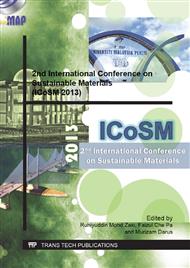[1]
M. M. Kabir, H. Wang, K. T. Lau, and F. Cardona, "Chemical treatments on plant-based natural fibre reinforced polymer composites: An overview," Composites Part B: Engineering, vol. 43, pp.2883-2892, 2012.
DOI: 10.1016/j.compositesb.2012.04.053
Google Scholar
[2]
H. Ku, H. Wang, N. Pattarachaiyakoop, and M. Trada, "A review on the tensile properties of natural fiber reinforced polymer composites," Composites Part B: Engineering, vol. 42, pp.856-873, 2011.
DOI: 10.1016/j.compositesb.2011.01.010
Google Scholar
[3]
H. Ismail, A. Hamid Abdullah, and A. Abu Bakar, "Kenaf Core Reinforced High-density Polyethylene/Soya Powder Composites: The Effects of Filler Loading and Compatibilizer " Journal of Reinforced Plastics and Composites, vol. 29, pp.2489-2497, 2010.
DOI: 10.1177/0731684409354392
Google Scholar
[4]
S. Kalia, B. S. Kaith, and I. Kaur, "Pretreatments of natural fibers and their application as reinforcing material in polymer composites—A review," Polymer Engineering & Science, vol. 49, pp.1253-1272, 2009.
DOI: 10.1002/pen.21328
Google Scholar
[5]
N. Sgriccia, M. C. Hawley, and M. Misra, "Characterization of natural fiber surfaces and natural fiber composites," Composites Part A: Applied Science and Manufacturing, vol. 39, pp.1632-1637, 2008.
DOI: 10.1016/j.compositesa.2008.07.007
Google Scholar
[6]
L. Y. Mwaikambo and M. P. Ansell, "Chemical modification of hemp, sisal,jute and kapok fibres by alkalisation," Journal of Applied Polymer Science, vol. 84, pp.2222-2234, 2002.
DOI: 10.1002/app.10460
Google Scholar
[7]
K. Joseph, S. Thomas, and C. Pavithran, "Effect of chemical treatment on the tensile properties of short sisal fibre-reinforced polyethylene composites," Polymer, vol. 37, pp.5139-5149, 1996.
DOI: 10.1016/0032-3861(96)00144-9
Google Scholar
[8]
L. Y. Mwaikambo and M. P. Ansell, "The effect of chemical treatment on the properties of hemp, sisal, jute and kapok for composite reinforcement," Die Angewandte Makromolekulare Chemie, vol. 272, pp.108-116, 1999.
DOI: 10.1002/(sici)1522-9505(19991201)272:1<108::aid-apmc108>3.0.co;2-9
Google Scholar
[9]
M. A. Sawpan, K. L. Pickering, and A. Fernyhough, "Effect of various chemical treatments on the fibre structure and tensile properties of industrial hemp fibres," Composites Part A: Applied Science and Manufacturing, vol. 42, pp.888-895, 2011.
DOI: 10.1016/j.compositesa.2011.03.008
Google Scholar
[10]
F. Febrianto, D. Setyawati, M. Karina, E. S. Bakar and Y. S. Hadi,. "Influence of Wood Flour and Modifier Contents on the Physical and Mechanical Properties of Wood Flour-Recycle Polypropylene Composites," Journal of Biological Sciences, vol. 6, pp.337-343, 2006. .
DOI: 10.3923/jbs.2006.337.343
Google Scholar
[11]
H. P. San, L. A. Nee, and H. C. Meng, "Physical and Bending Properties of Injection Moulded Wood Plastic Composites Boards," Journal of Engineering and Applied Sciences, vol. 3, 2008.
Google Scholar
[12]
S. H. Aziz and M. P. Ansell, "The effect of alkalization and fibre alignment on the mechanical and thermal properties of kenaf and hemp bast fibre composites: Part 1 – polyester resin matrix," Composites Science and Technology, vol. 64, pp.1219-1230, 2004.
DOI: 10.1016/j.compscitech.2003.10.001
Google Scholar
[13]
A. M. M. Edeerozey, H. M. Akil, A. B. Azhar, and M. I. Z. Ariffin, "Chemical modification of kenaf fibers," Materials Letters, vol. 61, pp.2023-2025, 2007.
DOI: 10.1016/j.matlet.2006.08.006
Google Scholar
[14]
H. M. Akil, M. F. Omar, A. A. M. Mazuki, S. Safiee, Z. A. M. Ishak, and A. Abu Bakar, "Kenaf fiber reinforced composites: A review," Materials & Design, vol. 32, pp.4107-4121, 2011.
DOI: 10.1016/j.matdes.2011.04.008
Google Scholar
[15]
L. Y. Mwaikambo and M. P. Ansell, "Hemp fibre reinforced cashew nut shell liquid composites," Composites Science and Technology, vol. 63, pp.1297-1305, 2003.
DOI: 10.1016/s0266-3538(03)00101-5
Google Scholar
[16]
P. Saha, Manna, S., Chowdhury, S.R,. Sen, R, Roy, D., and Adhikari,, B.,, "Enhancement of Tensile Strength of Lignocellulosic Jute Fibers By Alkali-Steam Treatment,," Bioresource Technology vol. 101, pp.3182-3187, 2010.
DOI: 10.1016/j.biortech.2009.12.010
Google Scholar
[17]
E. Sinha and S. K. Rout, "Influence of fibre-surface treatment on structural, thermal and mechanical properties of jute," Journal of Materials Science vol. 43, pp.2590-2601, 2009.
DOI: 10.1007/s10853-008-2478-4
Google Scholar
[18]
J. M. Fang, R. C. Sun, and J. Tomkinson, "Isolation and characterization of hemicelluloses and cellulose from rye straw by alkaline peroxide extraction," Cellulose, vol. 7, pp.87-107, 2000.
Google Scholar


